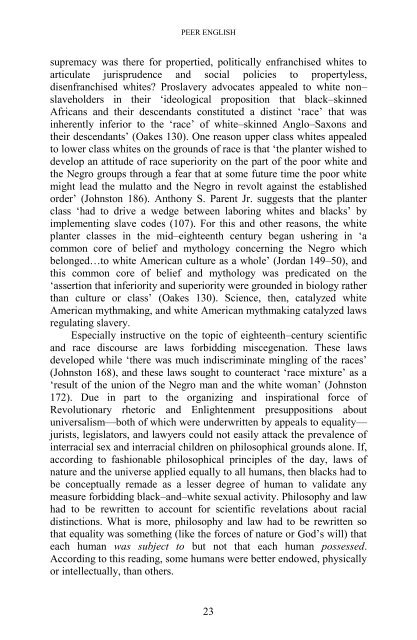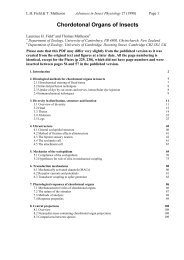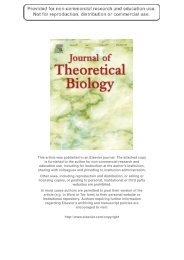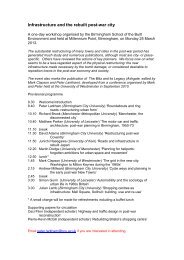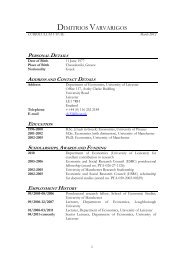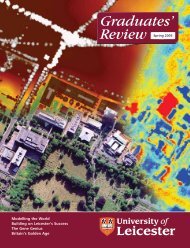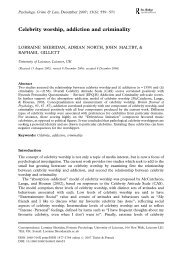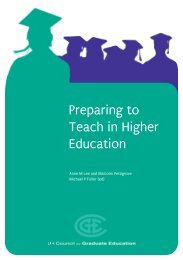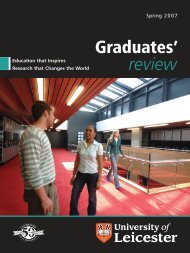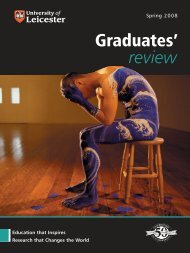From Natural Law to Natural Inferiority
From Natural Law to Natural Inferiority
From Natural Law to Natural Inferiority
Create successful ePaper yourself
Turn your PDF publications into a flip-book with our unique Google optimized e-Paper software.
PEER ENGLISHsupremacy was there for propertied, politically enfranchised whites <strong>to</strong>articulate jurisprudence and social policies <strong>to</strong> propertyless,disenfranchised whites? Proslavery advocates appealed <strong>to</strong> white non–slaveholders in their ‘ideological proposition that black–skinnedAfricans and their descendants constituted a distinct ‘race’ that wasinherently inferior <strong>to</strong> the ‘race’ of white–skinned Anglo–Saxons andtheir descendants’ (Oakes 130). One reason upper class whites appealed<strong>to</strong> lower class whites on the grounds of race is that ‘the planter wished <strong>to</strong>develop an attitude of race superiority on the part of the poor white andthe Negro groups through a fear that at some future time the poor whitemight lead the mulat<strong>to</strong> and the Negro in revolt against the establishedorder’ (Johns<strong>to</strong>n 186). Anthony S. Parent Jr. suggests that the planterclass ‘had <strong>to</strong> drive a wedge between laboring whites and blacks’ byimplementing slave codes (107). For this and other reasons, the whiteplanter classes in the mid–eighteenth century began ushering in ‘acommon core of belief and mythology concerning the Negro whichbelonged…<strong>to</strong> white American culture as a whole’ (Jordan 149–50), andthis common core of belief and mythology was predicated on the‘assertion that inferiority and superiority were grounded in biology ratherthan culture or class’ (Oakes 130). Science, then, catalyzed whiteAmerican mythmaking, and white American mythmaking catalyzed lawsregulating slavery.Especially instructive on the <strong>to</strong>pic of eighteenth–century scientificand race discourse are laws forbidding miscegenation. These lawsdeveloped while ‘there was much indiscriminate mingling of the races’(Johns<strong>to</strong>n 168), and these laws sought <strong>to</strong> counteract ‘race mixture’ as a‘result of the union of the Negro man and the white woman’ (Johns<strong>to</strong>n172). Due in part <strong>to</strong> the organizing and inspirational force ofRevolutionary rhe<strong>to</strong>ric and Enlightenment presuppositions aboutuniversalism—both of which were underwritten by appeals <strong>to</strong> equality—jurists, legisla<strong>to</strong>rs, and lawyers could not easily attack the prevalence ofinterracial sex and interracial children on philosophical grounds alone. If,according <strong>to</strong> fashionable philosophical principles of the day, laws ofnature and the universe applied equally <strong>to</strong> all humans, then blacks had <strong>to</strong>be conceptually remade as a lesser degree of human <strong>to</strong> validate anymeasure forbidding black–and–white sexual activity. Philosophy and lawhad <strong>to</strong> be rewritten <strong>to</strong> account for scientific revelations about racialdistinctions. What is more, philosophy and law had <strong>to</strong> be rewritten sothat equality was something (like the forces of nature or God’s will) thateach human was subject <strong>to</strong> but not that each human possessed.According <strong>to</strong> this reading, some humans were better endowed, physicallyor intellectually, than others.23


